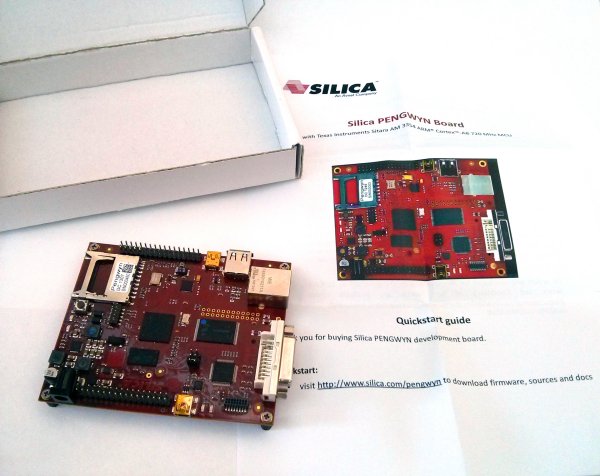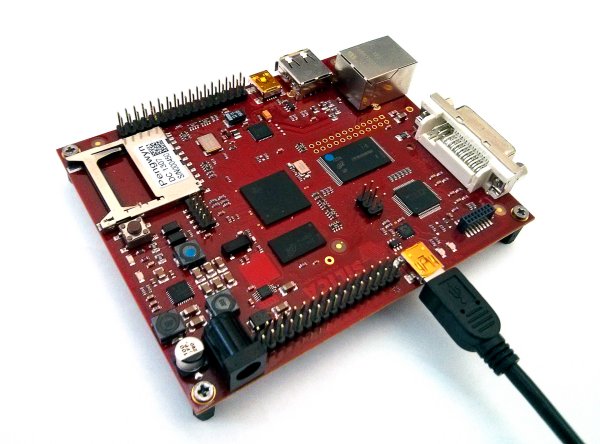1. Unboxing¶
This powerful board comes with this beautiful box

Pengwyn takes the power from the mini-USB connector CN6 and/or connector CN1. The board is not shipped with an external power adapter.

The NAND on the board has been programmed to let Pengwyn boot a qt4e-demo-image-pengwyn image generated with Yocto.
What are we waiting for? Lets boot the board!
- First of all, make sure the board can boot entirely from the NAND by setting J1, J2 and J3 opened:

- Connect the DVI-D connector CN11 to your monitor/television by means of an DVI-D cable
- Shall we power on the board for the first time? Of course!

which you can connect, by means of a mini-USB cable, to your personal computer.
Note
Every operating system has its own killer application to give you a serial terminal interface. In this guide, we are assuming your host operating system is Ubuntu.
On a Linux (Ubuntu) host machine, the console is seen as a ttyUSB***X* device (where X is a number) and you can access to it by means of an application like minicom.
Minicom needs to know the name of the serial device. The simplest way for you to discover the name of the device is by looking to the kernel messages, so:
- clean the kernel messages
sudo dmesg -c- connect the mini-USB cable to the board already powered-on
- display the kernel messages
dmesg- read the output
[ 2614.290675] usb 3-4: >new full-speed USB device number 4 using xhci_hcd
[ 2614.313854] usb 3-4: >New USB device found, idVendor=0403, idProduct=6015
[ 2614.313861] usb 3-4: >New USB device strings: Mfr=1, Product=2, SerialNumber=3
[ 2614.313865] usb 3-4: >Product: FT230X Basic UART
[ 2614.313868] usb 3-4: >Manufacturer: FTDI
[ 2614.313870] usb 3-4: >SerialNumber: DN002OZI
[ 2614.379284] usbcore: registered new interface driver usbserial
[ 2614.379298] usbcore: registered new interface driver usbserial_generic
[ 2614.379306] USB Serial support registered for generic
[ 2614.379310] usbserial: USB Serial Driver core
[ 2614.387899] usbcore: registered new interface driver ftdi_sio
[ 2614.387914] USB Serial support registered for FTDI USB Serial Device
[ 2614.387997] ftdi_sio 3-4:1.0: >FTDI USB Serial Device converter detected
[ 2614.388029] usb 3-4: >Detected FT-X
[ 2614.388031] usb 3-4: >Number of endpoints 2
[ 2614.388034] usb 3-4: >Endpoint 1 MaxPacketSize 64
[ 2614.388035] usb 3-4: >Endpoint 2 MaxPacketSize 64
[ 2614.388037] usb 3-4: >Setting MaxPacketSize 64
[ 2614.388260] usb 3-4: >FTDI USB Serial Device converter now attached to /dev/ttyUSB0
[ 2614.388288] ftdi_sio: v1.6.0:USB FTDI Serial Converters DriverAs you can see, here the device has been recognized as /dev/ttyUSB0.
Now that you know the device name, run minicom:
sudo minicom -wsIf minicom is not installed, you can install it with:
sudo apt-get install minicomthen you can setup your port with these parameters:
+-----------------------------------------------------------------------+
| A - Serial Device : /dev/ttyUSB0 |
| B - Lockfile Location : /var/lock |
| C - Callin Program : |
| D - Callout Program : |
| E - Bps/Par/Bits : 115200 8N1 |
| F - Hardware Flow Control : No |
| G - Software Flow Control : No |
| |
| Change which setting? |
+-----------------------------------------------------------------------+
| Screen and keyboard |
| Save setup as dfl |
| Save setup as.. |
| Exit |
| Exit from Minicom |
+--------------------------+If on your system the device has not been recognized as /dev/ttyUSB0, just replace /dev/ttyUSB0 with the proper device.
Once you are done configuring the serial port, you are back to minicom main menu and you can select exit.
Give root to the login prompt:
Board
pengwyn login: root
and press Enter.
Note
Sometimes, the time you spend setting up minicom makes you miss all the output that leads to the login and you see just a black screen, press enter then to get the login prompt.
Enjoy!
